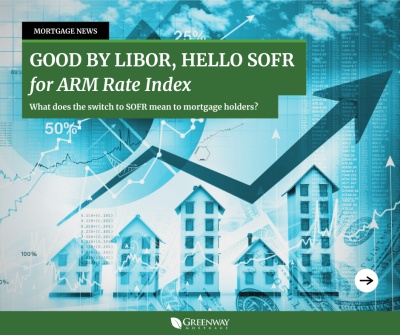Blog
Goodbye LIBOR, Hello SOFR for ARM Rate Index
Nov 17
4:01
AM
Category | Mortgage Industry Updates & Announcements

A change is underway in the world of adjustable-rate mortgages and mortgage-backed loans such as revolving home equity lines of credit, known as HELOCs. For decades, the rates on those loans and a variety of other financial products were determined by an index called the London Interbank Overnight Rate (LIBOR). This is now being phased out in favor of a new index called the Secured Overnight Financing Rate (SOFR). Sometime after 2021, LIBOR is expected to be discontinued. However, the transition has already begun.
If you have an adjustable rate mortgage, a home equity line of credit or a reverse mortgage, it may be a good time to check with your servicer about which index your mortgage loan is tied to. Why? It could affect your rate the next time you’re due for an adjustment. To understand how this change might affect you, let’s dive into the key differences between LIBOR and SOFR.
LIBOR? SOFR? What’s the deal?
LIBOR and SOFR both measure the cost of short-term borrowing, though they measure that cost differently.
The London Interbank Offered Rate (LIBOR):
-
A benchmark interest rate at which major global banks lend to one another in the international interbank market for short-term loans.
-
A forward-looking average rate, computed daily, at which a contributor bank can obtain unsecured financing in the London interbank market, in a process overseen by the ICE Benchmark Administration (IBA). Based partially on market-data “expert judgment”.
-
Based on 5 currencies: the U.S. Dollar, Euro, British Pound, Japanese Yen and Swiss Franc.
-
Incorporates a built-in credit-risk component because it represents the average cost of borrowing by a bank.
-
LIBOR has 7 varying rates on terms of one day to one year.
-
LIBOR is a critical component of the financial system, hardwired into not only global derivatives but also business loans, securitizations, floating rate notes, adjustable mortgages, and student loans.
Secured Overnight Financing Rate (SOFR):
-
Unlike LIBOR, SOFR is a secured overnight (backward looking), risk-free rate based on actual transactions collateralized by Treasurys.
-
It is an influential interest rate that banks use to price U.S. dollar-denominated derivations and loans.
-
Purely a daily rate.
-
Seen as preferable to LIBOR since it is based on data from observable transactions rather than on estimated borrowing rates. Also, because these transactions can be observed by anyone, it’s also less easily manipulated.
Why the change? LIBOR came under scrutiny in the aftermath of the Great Recession because bankers were manipulating the rate. In turn, SOFR was developed to be a more accurate metric that would be harder for a small pool of banks to manipulate.
Out with the old, in with the new!
Sometime after 2021, LIBOR is expected to be discontinued. However, the transition has already begun and is being overseen by the Alternative Reference Rates Committee (ARRC) of the Federal Reserve Board and New York Fed. According to the ARRC, by the end of 2020, mortgage holders with interest rates pegged to LIBOR should hear form their servicer about the SOFR transition for their specific mortgage loan.
The change will affect loans that use LIBOR as the index such as:
-
Some adjustable (or variable) rate loans and lines of credit like adjustable-rate mortgages (ARMs)
-
Reverse mortgages
-
Home equity lines of credit
-
Credit cards
-
Auto loans
-
Student loans
-
And any other personal loans
What does the switch to SOFR mean to Mortgage Holders?
Most mortgage-holders and applicants may not be affected by this change. Why? Adjustable Rate mortgages aren’t as popular as they once were and have lost even more appeal during the COVID-19 pandemic with general interest rates at all-time lows. Mortgage holders who have fixed-rate mortgages will not be affected as they are not tied to LIBOR or SOFR.
However, the changeover does mean that some loans could see slight adjustments when their underlying index is switched. If you have an adjustable-rate mortgage, home equity loan or reverse mortgage, now is a good time to revisit the fine print and find out exactly how your rate is determined. For instance, if it’s SOFR- or Treasury-based, nothing will change, but if it’s a LIBOR-based loan, you’ll want to speak to your servicer about when it will change over and what that could mean in your individual situation.


.png)

